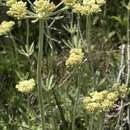Comments
provided by eFloras
According to N. J. Turner et al. (1980), plants of the narrow-leaved phase (var. angustifolum) were used for colds, tuberculosis, and other lung ailments, and to treat infected cuts and sores (a decoction of roots and stems). V. F. Ray (1933) reported that a decoction of roots of such plants was taken for diarrhea. E. V. Steedman (1930) said that they were taken for stomachaches, used in steambaths to treat aching joints and muscles, and had a role in a purifying ceremony held in sweatlodges. Steedman also indicated that a strong decoction was taken by the Thompson Indians to treat syphilis.
- license
- cc-by-nc-sa-3.0
- copyright
- Missouri Botanical Garden, 4344 Shaw Boulevard, St. Louis, MO, 63110 USA
Description
provided by eFloras
Herbs, spreading mats, infrequently polygamodioecious, 1-6 × 2-10, tomentose to floccose. Stems: caudex spread-ing; aerial flowering stems erect, slender, solid, not fistulose, arising at nodes of caudex branches and at distal nodes of short, nonflowering aerial branches, (0.5-)1-3(-4) dm, often with a whorl of (2-)5-10, linear to oblanceolate, leaflike bracts ca. midlength, 0.5-4(-5) × 0.2-1 (1.5) cm, mostly tomentose to floccose. Leaves in loose rosettes; petiole 0.5-3 cm, usually floccose; blade usually linear to oblanceolate, (1.5-)2-5 × 0.2-1(-1.5) cm, densely white-lanate to tomentose on both surfaces or only abaxially, thinly floccose or glabrous and green adaxially, margins entire, plane. Inflorescences simple or compound-umbellate, rarely reduced and compact, 1-10 × 1-10 cm; branches tomentose to floccose; bracts 3-10 or more, leaflike at proximal node, oblanceolate to linear, 0.3-1 × 0.2-0.4 cm, usually scalelike distally, 1-5 × 0.5-2.5 mm. Involucres 1 per node, turbinate to campanulate, 3-4.5 × 2.5-5(-6) mm, tomentose, rarely glabrous; teeth 6-12 or more, lobelike, reflexed, 1.5-5 mm. Flowers 4-9 mm, including 1.5-3 mm stipelike base; perianth white to cream or ochroleucous, glabrous; tepals monomorphic, spatulate to oblong-ovate; stamens exserted, 4-8 mm; filaments pilose proximally. Achenes light to dark brown, (2-)3.5-5 mm, glabrous except for sparsely pubescent beak.
- license
- cc-by-nc-sa-3.0
- copyright
- Missouri Botanical Garden, 4344 Shaw Boulevard, St. Louis, MO, 63110 USA

